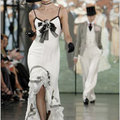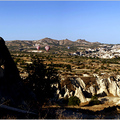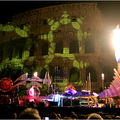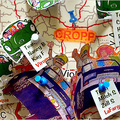NAMING rights for a museum’s grand spaces are part of the deal for valued donors these days. But when the New Museum of Contemporary Art began its capital campaign for a $50 million building on the Lower East Side of Manhattan, the bathrooms were the first places to be christened.
“I’m 83,” said Jerome L. Stern, a retired venture capitalist, “and I thought it would be nice to see my name in a place where I’m going to spend a lot of time.”
As a result of his generosity, the museum’s four public bathrooms will be the Jerome and Ellen Stern Restrooms. While Mr. Stern would not say exactly what they cost, he said the price tag was in the six figures.
At institutions like the Metropolitan Museum of Art or the Museum of Modern Art, such a check may get you an invitation to a fancy dinner or a peek at a private art collection with one of its curators, but it would not get your name on so much as a filing cabinet. Nonetheless, the art world uptown is paying close attention to the New Museum’s building rising on the Bowery. When it opens at the end of the year, its jutting, silvery configuration will be an architectural landmark for New York City and another addition to the cultural building boom sweeping the country.
But beyond the concrete and steel, the New Museum shows how a lesser-known institution can attract attention by taking chances. It hired an adventurous team of architects. It has diversified its board of trustees. It is doubling its staff, bolstering its exhibition schedule and greatly expanding its education activities.
Combine that with the museum’s re-energized mission — to showcase the newest art — and the result is an institution that poses a bold challenge to established museums. With the contemporary art market boiling over as newly rich collectors compete at fairs, auctions and galleries, the New Museum will be a ready-made hive for dealers, clients and the Prada-clad art-world swarm that follows them. For artists, having works on display there could bring faster recognition and probably higher prices.
The image of scrappy contender extends to the trustees, who like to say they are “shirt-sleeve, not black-tie” and delight in flouting the conventions of older museums.
Lisa Phillips, the museum’s director, spent 23 years as a curator at the Whitney Museum of American Art before joining the New Museum in 1999. She “has put together a board with people other institutions have wanted to get on their boards,” said Arne Glimcher, chairman of the PaceWildenstein Gallery. “But they choose the New Museum because they sense the energy and commitment.”
She has also attracted prominent talent to work with her, like Massimiliano Gioni, a curator at the most recent Berlin Biennial; Richard Flood, the former chief curator at the Walker Art Center in Minneapolis; and Laura Hoptman, a former curator at the Carnegie Museum of Art in Pittsburgh.
For the opening exhibition in the new building, the three curators are putting together an international sculpture show.
Ms. Phillips’s credentials are not too dissimilar to those of the founder of the New Museum, Marcia Tucker, who started it in 1977, the day after she was fired from her position as a curator at the Whitney. Her dismissal came just two weeks after the closing of a Richard Tuttle exhibition, at the time one of the Whitney’s most provocative.
The New Museum first opened in a poky office space on Hudson Street and then moved several times. Its new home, designed by Kazuyo Sejima and Ryue Nishizawa of the Tokyo firm Sanaa, will be a seven-story 60,000-square-foot building on the site of an old parking lot at 235 Bowery at Prince Street, a dramatic configuration of irregularly stacked boxes clad in shiny metal. The museum will have more than twice its previous exhibition space, as well as a floor for educational activities, a 200-seat theater, a cafe and a bookstore.
In the gazetteer of small New York museums, the New Museum is racing to the top of the page. The Dia Art Foundation lost its most generous donor last year when Leonard Riggio resigned from the foundation, and it has no place in Manhattan to mount exhibitions after closing its two Chelsea spaces in 2004. The Drawing Center, without a director for a year, is moving from its SoHo home to a former Fulton Fish Market site near the South Street Seaport.
“It’s not about the money, its about the people; that’s why we’ve been so successful,” said Saul Dennison, the longtime president of the New Museum. “Everyone is passionate about contemporary art, and everyone on the board actually likes each other.”
Larger institutions require people to make multimillion-dollar donations to get on a board, but at the New Museum a candidate has to prove a commitment to contemporary art and the ability to get along with the current trustees. Being a board member requires a minimum annual contribution of $25,000 as well as a six-figure check for the building campaign, although several trustees stretched into the seven figures, Ms. Phillips said. Trustees say they have many more people wanting to join the board — which Ms. Phillips has expanded to 35 from 18 — than will ever win a place.
Before asking someone to join the board, members want prospective trustees to become involved with the museum by joining a museum committee, which often involves participating in museum-organized trips.
“We like to spend time getting to know the person before getting married,” Ms. Phillips said. “Our expectations are completely different than, say, the MoMA board.”
One trustee, James-Keith Brown, started his association with the New Museum in the mid-1990s by joining the producers council, a $5,000-a-year benefactor group that does things like visiting artists’ studios and taking trips led by the museum’s curators. He recalls that as a young contemporary art collector, he found it an entertaining group that offered a good opportunity to meet like-minded collectors.
“At the time, I was also working on the young collectors group at the Guggenheim,” he said. “But this was different. It showed me a new way of looking at things.”
With the hedge fund professionals fueling the market for contemporary art, it would be easy to fill a board with young Wall Street wizards. But the museum’s board isn’t just made up of financiers like Mr. Brown — or of New Yorkers. The trustees are an international group ranging from collectors in their early 40s to people in their 80s, from retailers to curators.
The board spent a year scouring the city for its new home. “It wasn’t till we saw the empty parking lot on the Lower East Side that we knew we’d found the spot,” Ms. Phillips said. “The board saw the potential before I did. They saw right away how consistent it was with the museum’s mission. They loved the fact that the neighborhood was rough and the street was languishing, and that it was a major avenue with easy subway access.”
Knowing how much to spend was the first order of business. That meant knowing what the museum could get for its previous home in SoHo. (In 2002, it sold for $18 million.) The New Museum was able to buy the Bowery site for $5 million. That meant it had to start a capital campaign drive to raise an estimated $64 million to cover the building and endowment. To date, more than $60 million has been raised.
Unlike, say, the Whitney, MoMA or Dia, which have all had one or two supergenerous leaders writing unusually big checks to carry a project, the New Museum does not have what it calls “the 500-pound gorilla.”
“This is a group that has its eye on the ball,” said Stephanie French, a board member who was the head of philanthropy at Philip Morris and now works in wealth management at U.S. Trust. “It’s a self-examining group. We know we need to be realistic, and as the budget grows, we realize we’ll have to keep raising money.”
When she founded the museum, Ms. Tucker decided it should buy works and sell them 10 years later so that its collection would always be new. It was an innovative plan that was never carried out. The museum now has a modest collection of about 1,000 works in many media. Ms. Phillips said that while it did not consider itself a collecting institution, it will add to its collections through gifts and commissions.
Many on the board think that not having a large collection is a big advantage. For starters, it’s difficult for a museum dedicated to new art to have a collection. “We want to always be on the cutting edge,” said Dieter Bogner, an independent museum curator from Vienna. “It’s a building for the future, the next generation, unlike most museums, which are a place to see the past.”
William E. Ford, who is in the private equity business and has been a board member for two and a half years, said: “When you look at programs at MoMA, the Whitney or the Guggenheim, they all need to mount blockbusters to support their buildings. The gravity of their collections is a lens through which they see themselves. Since we’re not bound by these constraints, it allows us to concentrate on our programs.”
Mitzi Eisenberg, a trustee who was one of the founders of Bed Bath & Beyond, said she was proud that the museum took risks. “We’ve given a chance to artists many people had never heard of, like Richard Prince and Jeff Koons,” she said. Now they are superstars.
Ms. Phillips said the museum planned to continue exhibiting new talent and underrecognized artists, giving many their first opportunity to be shown in a museum.
Officials at the museum also say that once the new building opens, it will change the complexion of the Lower East Side, just as its presence changed SoHo in the early 1980s, when it provoked a rush of galleries to Broadway.
“It will become an exciting place to go,” Ms. Eisenberg said.
With growth comes the fear that the museum may become more like others — a larger place with a bigger building and even more ambition — which could mean losing its edge and settling in to middle age.
Paul T. Schnell, a Manhattan lawyer and longtime board member, sees the challenge ahead. “We can’t become a victim of our own success,” he said. “We’re all very conscious that there’s a risk of losing our edge. It’s something the board and the staff worry about. So much so, that we’re all committed to making sure that that won’t happen.”






